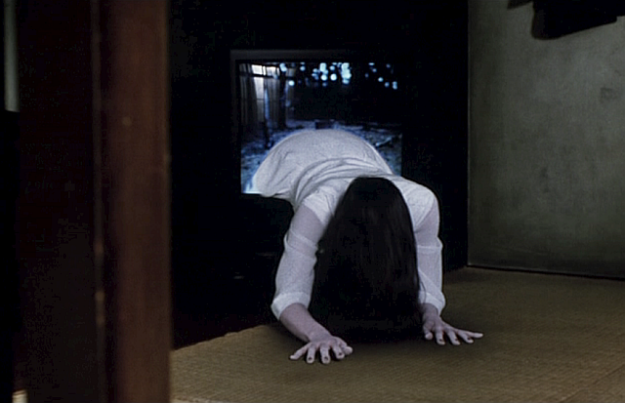
I might not have mentioned, but I was recently at FrightFest, which is always the highlight of the year for me. We’d been promised a mysterious new Adam Wingard picture entitled The Woods, which was set to be the very latest thing in scaring audiences’ pants off. Well, as it turned out, it wasn’t really The Woods at all, but rather a new sequel to The Blair Witch Project. At the same time, it turned out we weren’t really getting to see it at all, but THEN it turned out that instead we were getting Sadako vs. Kayako, i.e. The Ring vs. The Grudge. For me, that was a good result – I’d been eagerly awaiting Sadako vs. Kayako since its announcement, & nothing could dampen that enthusiasm.
As it turned out, the picture was only OK, offering a few interesting ideas but undermining itself with tongue-in-cheek humour & never really reaching the nightmare pitch achieved in the best of its predecessors (Ringu, Ju-On: The Curse, Ju-On: The Grudge, The Ring). Perhaps this shouldn’t be too surprising. Those films all came out within a remarkably short period of time – a Golden Age for what was called J-Horror.
J-Horror is not simply any horror that comes out of Japan, but in order to qualify it does have to be Japanese. The films from J-Horror’s Golden Age favoured vengeful spirits, usually girls in white dresses with stringy black hair. The approach to horror, while often incorporating a hefty dose of surrealism, was subtle too, usually avoiding gore, or even any specific depictions of harm, in favour of maddeningly relentless pursuits. They were also heavily reliant on intelligent use of the frame, hiding characters in background shadows or just out of shot. Naturally, this meant the films required talented directors making them work, which is exactly what they got: Hideo Nakata helmed Ringu, Ringu 2 & The Ring Two, leaving other, less talented directors to follow him on pictures such as Ringu‘s discredited sequel Rasen, the surprisingly effective prequel film Ringu 0: Birthday, & the tacky, CGI-filled later revivals Sadako 3D & Sadako 2 3D. Hideo Nakata’s relationship to Ju-On is similar; the series had its origins in the shorts “Katasumi” & “4444444444” released in the anthology Gakkô no kaidan G. Nakata expanded around them with Ju-On: The Curse & Ju-On: The Curse 2, before giving the series its first reboot with Ju-On: The Grudge, which earned its own sequel in Ju-On: The Grudge 2. Following the success of Ringu‘s even better US remake The Ring, lavishly staged by later Pirates of the Caribbean director Gore Verbinski, Ju-On: The Grudge received a similar US treatment, yet again directed by Shimizu, who would also stay on for The Grudge 2 before abandoning both the Japanese & American iterations of his franchise. The Grudge 3 went straight to home video, but the American series continues to hold out hope, with a reboot reportedly in the works. In Japan, the series never quite fell out of fashion, & the spin-off films Ju-On: White Ghost, which was pretty good, & Ju-On: Black Ghost, which was less so, marked the series’ tenth anniversary before yet another reboot in Ju-On: The Beginning of the End, whose sequel was Ju-On: The Final Curse. Sadako vs. Kayako, for those who are interested, reboots both series yet again in order to incorporate some minor changes to the mythos.
The US pictures coming out at this time that weren’t remakes of Japanese pictures ended up looking like they might as well be, while the cinemas of China & Korea both responded to the horror waves coming from Japan. A neighbouring, yet different, genre enjoying a little Golden Age of its own at the same time was Asian extreme, best represented by Korean Park Chan-Wook & Japanese Takashi Miike, while the tactics of J-horror fed into, & from, other media, such as the horror manga of Junji Ito, the novels of Kōji Suzuki, or the many survival horror videogames released in the same period.
Nakata & Shimizu made some other excellent horrors; Nakata delivered his masterpiece in Dark Water, which also had a US remake, while Nakata delivered the Junji Ito adaptation Tomie: Rebirth, the Lovecraftian Marebito, The Shock Labyrinth, & Tormented. But other directors were active, too; if you want to easily keep track of them, why not try the J-Horror Theater imprint? It gathered six of J-Horror’s leading talents to deliver one picture each; Nakata & Shimizu pitched in with Kaidan & Reincarnation respectively, while the other pictures were Infection (from Masayuki Ochiai of Parasite Eve, Saimin, Shutter, & Kotodama – Spiritual Curse before taking over for Shimizu on the Ju-On franchise); Premonition (from Tsuruta Norio of Ringu 0: Birthday & Kakashi, which was based on a Junji Ito manga); Retribution (from Kiyoshi Kurosawa, best-known for Pulse); & finally Kyōfu (from Ringu screenwriter Hiroshi Takahashi). The J-Horror Theater series had mostly died off by its later entries, however, as had the brief, incredibly terrifying success of the genre. Sometimes all it takes to create a Golden Age is one or two great talents. Or maybe there was just something in the water in the late-90s.